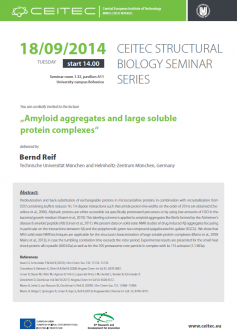
You are cordially invited to the lecture "Amyloid aggregates and large soluble protein complexes" delivered by Bernd Reif, Technische Universität München and Helmholtz-Zentrum München, Germany.
WHEN: September 18, 2014 from 14:00
WHERE: Seminar room 1.32, pavilion A11, University Campus Bohunice, Brno
Abstract:
Perdeuteration and back-substitution of exchangeable protons in microcrystalline proteins in combination with recrystallization from D2O containing buffers reduces 1H, 1H dipolar interactions such that amide proton line widths on the order of 20 Hz are obtained (Chevelkov
et al., 2006). Aliphatic protons are either accessible via specifically protonated precursors or busing low amounts of H2O in the bacterial growth medium (Asami et al., 2010). This labeling scheme is applied to amyloid aggregates like fibrils formed by the Alzheimer's disease ß-amyloid peptide (Aß) (Linser et al., 2011). We present data on solid-state NMR studies of drug induced A aggregates focussing in particular on the interactions between A and the polyphenolic green tea compound epigallocatechin-gallate (EGCG). We show that MAS solid-state NMR techniques are applicable for the structural characterization of large soluble protein complexes (Mainz et al., 2009; Mainz et al., 2013), in case the tumbling correlation time exceeds the rotor period. Experimental results are presented for the small heat shock protein B crystallin (600 kDa) as well as for the 20S proteasome core particle in complex with its 11S activator (1.1 MDa).
Poster to download can be found
HERE.








